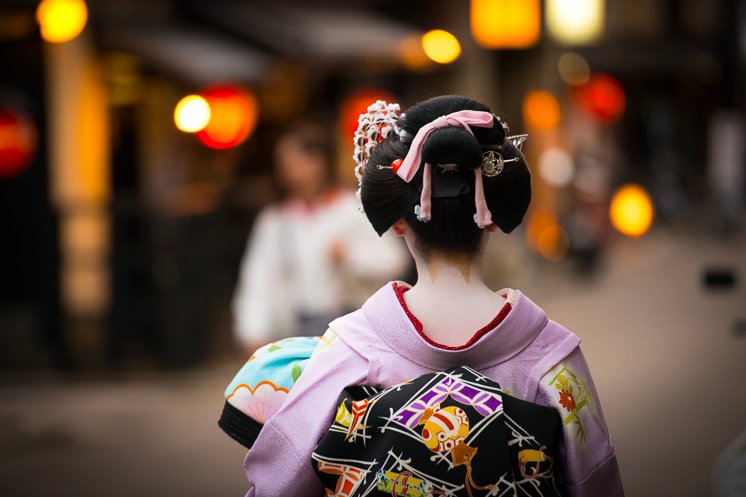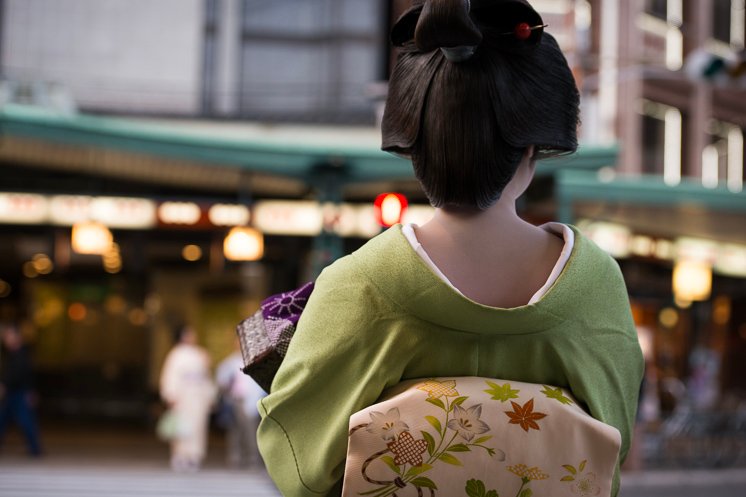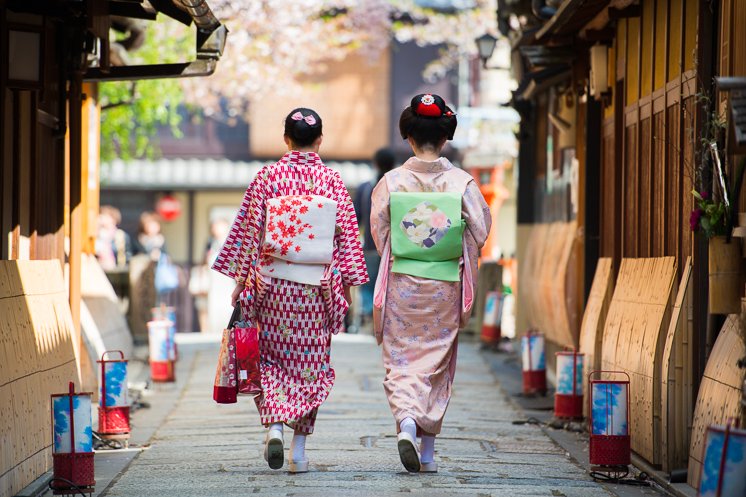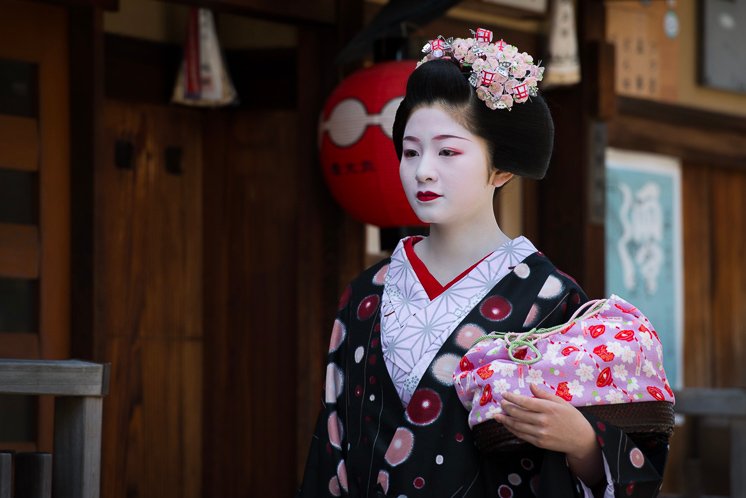Kyōto’s geisha culture, deeply entrenched in tradition, emphasizes subtle distinctions between its participants. The Maiko and Geiko, while both integral to this cultural milieu, differ in numerous ways. To the untrained eye, these differences might appear primarily aesthetic; however, for those familiar with the intricacies of the culture, every detail has significance. For instance, the comprehensive attire of a Maiko is so meticulously chosen based on seasons, events, and stages of apprenticeship that, when observing a photograph, an expert might deduce the precise week of the year it was taken. This specificity underscores the rigorous tradition and discipline inherent in geisha culture. This article aims to elucidate these visual cues, offering a deeper understanding of the distinctions between Maiko and Geiko.
The obi is not only functional, securing the kimono in place, but it also conveys information about the wearer’s status and position in the traditional arts community.

The kimono, a traditional Japanese garment, serves multiple functions beyond its primary role as attire. It also conveys symbolic messages, especially in the realm of geisha culture, showcasing one’s status and reflecting the wearer’s maturity and stage in their professional journey.
The undergarments used in traditional Japanese attire, while often concealed by the outer kimono, still hold significance. Their subtle visibility offers additional cues for distinguishing between Maiko and Geiko.


The art of hairstyling within the geisha culture is significant, symbolizing the transformation and growth an individual undergoes through her training and experiences.

Kanzashi, the traditional Japanese hair ornaments, are not only decorative but also significant in indicating the season, occasion, and the progression of a geisha’s career.

The items carried by both Maiko and Geiko offer insights into their roles, age, and progression within the geisha community.

In the traditional world of Maiko and Geiko, even the choice of footwear is steeped in symbolism. Varying in height, material, and style, these sandals not only complement their attire but also indicate their distinct stages in the geisha journey.
Within the intricacies of Maiko and Geiko culture, makeup serves as a precise indicator of their experience and rank. It’s a visual language, where the choice and application of each hue are meticulously considered.
Lipstick application among Maiko and Geiko isn’t just about aesthetic appeal but also signifies their journey and progression in their profession. The manner in which the lipstick is applied tells a lot about their experience and stage of training.
In the world of geisha culture, not only attire and accessories, but also behavior and company provide insightful cues to differentiate between Maiko and Geiko. The aura they emit and the people they are seen with can be used as markers of their experience and stage.
My series “Hanamachi I – Moments of Beauty” captures timeless moments in Kyōto’s geisha quarters, known as hanamachi. I created this series during a year-long stay in a small, traditional house located between two of the most beautiful hanamachi in Kyōto. As I passed through these neighborhoods daily, I became enamored with the aesthetic of the traditional Kyōto townhouses, called kyō-machiya, and the daily life within the geisha quarters.
As I spent more time exploring the streets on foot and by bike, I began to regularly see geiko (the term used for geisha in Kyōto) and maiko (apprentice geiko) going about their daily activities. The sophisticated and elegant way in which they move and behave, almost gliding along the streets in full attire, captivated me. These moments were like watching a play unfold before my eyes, like a scene from another era taking place in the present. These short, spontaneous “plays” take place daily without an audience and without following a fixed schedule. If you happen to be in the right place at the right time, you have the opportunity to witness and enjoy them.
With my photography, I aimed to capture these “plays” by setting the stage with the beautiful kyō-machiya architecture in the background, and waiting for interesting moments to happen within the frame. I often waited for hours without any results, but it was all worth it when everything came together for that one moment of fleeting beauty, only to disappear again a few seconds later.
I created this series in black and white, to keep a balance between the houses and the maiko and geiko, without the colorful kimono overpowering the architecture in the background. This also gives the pictures a sense of timelessness. Most of the scenes I photographed happened the same way 300 years ago as they are happening today. To me, there is a special beauty in the idea of moments that are fleeting but get repeated for hundreds of years through lived tradition.
It is my hope that my series “Moments of Beauty I” will transport the viewer to the streets of Kyōto’s hanamachi and allow them to experience the same sense of wonder and appreciation that I felt while creating it.
My series “Hanamachi I – Moments of Beauty” captures timeless moments in Kyōto’s geisha quarters, known as hanamachi. I created this series during a year-long stay in a small, traditional house located between two of the most beautiful hanamachi in Kyōto. As I passed through these neighborhoods daily, I became enamored with the aesthetic of the traditional Kyōto townhouses, called kyō-machiya, and the daily life within the geisha quarters.
As I spent more time exploring the streets on foot and by bike, I began to regularly see geiko (the term used for geisha in Kyōto) and maiko (apprentice geiko) going about their daily activities. The sophisticated and elegant way in which they move and behave, almost gliding along the streets in full attire, captivated me. These moments were like watching a play unfold before my eyes, like a scene from another era taking place in the present. These short, spontaneous “plays” take place daily without an audience and without following a fixed schedule. If you happen to be in the right place at the right time, you have the opportunity to witness and enjoy them.
With my photography, I aimed to capture these “plays” by setting the stage with the beautiful kyō-machiya architecture in the background, and waiting for interesting moments to happen within the frame. I often waited for hours without any results, but it was all worth it when everything came together for that one moment of fleeting beauty, only to disappear again a few seconds later.
I created this series in black and white, to keep a balance between the houses and the maiko and geiko, without the colorful kimono overpowering the architecture in the background. This also gives the pictures a sense of timelessness. Most of the scenes I photographed happened the same way 300 years ago as they are happening today. To me, there is a special beauty in the idea of moments that are fleeting but get repeated for hundreds of years through lived tradition.
It is my hope that my series “Moments of Beauty I” will transport the viewer to the streets of Kyōto’s hanamachi and allow them to experience the same sense of wonder and appreciation that I felt while creating it.